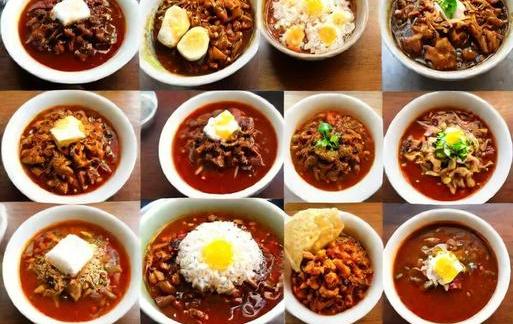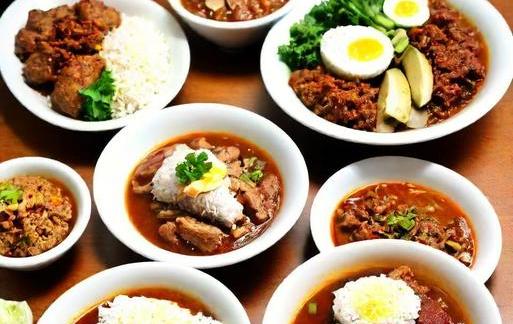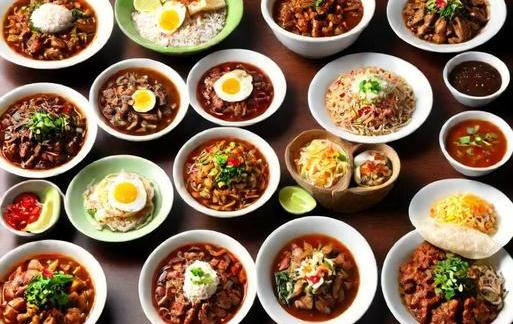- You are here:
- Home »
- Food
- » [REVEALED] Filipino Foods That Start With B
[REVEALED] Filipino Foods That Start With B
Note: This page contains affiliate links.
As an Amazon Associate, I earn from qualifying purchases when you click on the link, but you are not charged extra.
Filipino cuisine is a rich tapestry of flavors, influenced by a diverse history and a variety of ingredients. From savory to sweet, Filipino dishes are known for their unique taste that captivates the palate. In this article, we will explore a selection of Filipino foods that start with the letter "B," showcasing the culinary diversity of the Philippines.
Contents
List Of Filipino Foods That Start With B

1. Balut
Description: Balut is a unique Filipino delicacy that can be both intriguing and challenging for the uninitiated. It is a fertilized duck egg with a partially developed embryo, typically boiled and enjoyed with a pinch of salt and sometimes vinegar. Balut is not only a flavorful treat but also a cultural symbol in Filipino cuisine.
Taste: The flavor profile of balut is a combination of savory and slightly gamey, with a broth-like liquid inside the egg that adds richness to the experience.
2. Bibingka
Description: Bibingka is a popular Filipino rice cake that is often enjoyed during the Christmas season. Made with glutinous rice flour, coconut milk, and sugar, it is traditionally cooked in banana leaves and topped with salted duck eggs and grated coconut. The result is a sweet and savory cake that is a favorite among locals.
Taste: Bibingka has a dense, chewy texture with a hint of sweetness from the coconut milk and a savory touch from the salted duck eggs.
3. Bistek Tagalog
Description: Bistek Tagalog, also known simply as Bistek, is a Filipino beef steak dish characterized by thinly sliced beef marinated in soy sauce, calamansi juice, and garlic. It is often pan-fried and simmered until tender, then garnished with caramelized onions. Bistek Tagalog showcases the perfect balance of salty and tangy flavors.
Taste: The beef in Bistek Tagalog is tender and infused with the savory and slightly citrusy notes of the marinade, creating a delightful harmony of flavors.
4. Bicol Express
Description: Hailing from the Bicol region, Bicol Express is a spicy Filipino dish that features pork cooked in coconut milk, shrimp paste, and a generous amount of green chilies. The result is a fiery and flavorful dish that reflects the bold and spicy palate of the Bicolanos.
Taste: Bicol Express delivers a unique blend of creamy coconut milk, the umami richness of shrimp paste, and a kick of heat from the green chilies, creating a symphony of flavors that excite the taste buds.
5. Batchoy
Description: Batchoy is a noodle soup that originated from the La Paz district in Iloilo City. This comforting dish consists of egg noodles, pork offal, and beef, all bathed in a flavorful broth made from beef and pork bones. Batchoy is often garnished with crispy garlic, scallions, and sometimes a raw egg.
Taste: The broth of Batchoy is rich and hearty, while the combination of meats and noodles provides a satisfying texture. The addition of crispy garlic enhances the overall flavor profile.
6. Buko Pie
Description: Buko Pie is a popular Filipino pastry filled with young coconut (buko) strips mixed with sweetened condensed milk. Encased in a buttery and flaky crust, Buko Pie is a delightful dessert that has become a staple in Filipino celebrations and gatherings.
Taste: The filling of Buko Pie is sweet and creamy, with the natural freshness of young coconut shining through. The crust adds a buttery and slightly crunchy element to the overall experience.
7. Binagoongan
Description: Binagoongan is a Filipino dish known for its bold flavors, featuring pork or beef sautéed in shrimp paste (bagoong). It is often cooked with tomatoes, garlic, and chili peppers, creating a savory and pungent dish that is beloved by those who appreciate the unique taste of shrimp paste.
Taste: Binagoongan offers a complex flavor profile with the salty and briny notes of shrimp paste, the richness of pork or beef, and the slight acidity from the tomatoes, resulting in a dish that is both satisfying and memorable.
8. Brazo De Mercedes
Description: Brazo de Mercedes is a classic Filipino dessert that consists of a rolled meringue filled with a luscious custard made from egg yolks and condensed milk. This dessert is often baked until the meringue is golden brown, creating a visually appealing treat.
Taste: Brazo de Mercedes is a sweet indulgence with a delicate balance of sweetness from the meringue and the rich, creamy custard. The contrast in textures adds to the overall enjoyment of this elegant dessert.
9. Binalot
Description: Binalot is a traditional Filipino method of serving food, where a meal is wrapped in banana leaves. This eco-friendly and portable packaging method is not limited to a specific dish but can encompass a variety of Filipino favorites, such as adobo, tapa, or grilled fish.
Taste: The taste of binalot depends on the specific dish it contains, but the use of banana leaves imparts a subtle earthy aroma to the food, enhancing the overall dining experience.
10. Buko Salad
Description: Buko Salad is a refreshing Filipino dessert salad made with young coconut (buko), mixed fruits, and a sweetened cream dressing. It is a colorful and festive dish often served during special occasions and celebrations.
Taste: Buko Salad offers a medley of flavors, including the natural sweetness of fruits, the creamy texture of young coconut, and the richness of the sweetened cream dressing. It is a delightful and satisfying way to end a meal.
Filipino cuisine, with its diverse influences and unique combinations, never fails to amaze and delight food enthusiasts. The selection of Filipino foods that start with the letter "B" showcases the breadth and depth of flavors that define this vibrant culinary tradition. From the adventurous palate required for balut to the sweet elegance of Brazo de Mercedes, each dish tells a story of Filipino culture and culinary innovation. Whether you’re exploring Filipino cuisine for the first time or savoring the familiar tastes of home, these "B" foods offer a delectable journey through the heart of Filipino gastronomy.
Significance

The culinary landscape of the Philippines is a rich tapestry woven with diverse flavors, influenced by a fusion of indigenous, Spanish, Chinese, and American cuisines. Exploring Filipino cuisine unveils a treasure trove of unique and delightful dishes, each bearing a distinct mark of cultural heritage. In this gastronomic journey, we delve into Filipino foods that start with the letter “B”, uncovering the stories, flavors, and traditions behind these delectable creations.
Understanding the significance of Filipino foods that start with ‘B’ requires a glimpse into the cultural and historical context of the Philippines. The country’s cuisine is a testament to its vibrant history, with each dish reflecting the amalgamation of indigenous ingredients and international influences. ‘B’ is not merely a letter; it symbolizes the bounty of flavors that grace Filipino tables, connecting generations through shared meals and cherished recipes.
Category-Related

**1. ** Balut
One of the most iconic Filipino foods that start with ‘B’ is Balut. Hailing from the street food culture, Balut is a fertilized duck egg with a partially developed embryo. The egg is boiled and enjoyed with a sprinkle of salt or a dash of vinegar. While it may be perceived as exotic by some, Balut holds a special place in Filipino gastronomy, celebrated during gatherings and as a comfort food.
**2. ** Bibingka
Bibingka, a rice cake baked in a clay pot, is a beloved Filipino delicacy. Made from glutinous rice flour and coconut milk, Bibingka is often enjoyed during Christmas festivities. Topped with salted duck eggs, coconut shavings, and a drizzle of butter, this sweet and savory treat captures the essence of Filipino holiday traditions.
**3. ** Bistek Tagalog
Bistek Tagalog, a Filipino beef steak, is a testament to the country’s fusion of flavors. Thinly sliced beef is marinated in soy sauce, calamansi juice, and garlic, creating a savory and tangy profile. The dish is then pan-fried and simmered to perfection. Often served with rice, Bistek Tagalog is a classic Filipino comfort food, offering a harmonious blend of local and international influences.
**4. ** Bulalo
Bulalo, a hearty beef soup, exemplifies Filipino warmth and hospitality. The dish features beef shanks and marrow bones simmered to create a rich broth. Corn on the cob, plantains, and vegetables enhance the flavor, making Bulalo a favorite during cold weather or festive occasions. The communal act of sharing a steaming bowl of Bulalo underscores the cultural importance of togetherness in Filipino dining.
**5. ** Buko Pie
Buko Pie, a delectable coconut pie, is a testament to the abundance of tropical flavors in Filipino cuisine. The pie’s filling consists of young coconut meat mixed with sweetened condensed milk, creating a luscious and creamy texture. Encased in a flaky pastry crust, Buko Pie has become a staple in Filipino celebrations and a sought-after dessert for those with a sweet tooth.
Common Themes
**1. ** Rice As A Staple
One common theme among Filipino foods starting with ‘B’ is the prominent use of rice. Whether in the form of rice cakes like Bibingka or as a side dish accompanying savory mains such as Bistek Tagalog, rice is an integral part of Filipino meals. The versatility of rice in Filipino cuisine reflects its role as a staple that binds the diverse culinary traditions of the archipelago.
**2. ** Blend Of Flavors
Filipino cuisine is celebrated for its harmonious blend of flavors, often incorporating sweet, salty, sour, and umami elements in a single dish. This is evident in dishes like Bistek Tagalog, where the savory notes of soy sauce are complemented by the tanginess of calamansi juice. The artful balance of flavors is a hallmark of Filipino culinary expertise.
**3. ** Cultural Fusion
The ‘B’ dishes in Filipino cuisine showcase the country’s openness to cultural fusion. From the Chinese-influenced flavors in Bibingka to the Spanish-inspired Bistek Tagalog, Filipino foods reflect a history of cultural exchange. These dishes not only satisfy the taste buds but also narrate the story of the Philippines’ rich and diverse cultural heritage.
Interesting Facts
**1. ** Balut Festival
In Pateros, a municipality in the Philippines, Balut takes center stage during the annual Balut sa Puti Festival. The festival celebrates this unique street food, featuring various Balut dishes and competitions. It’s a testament to the cultural significance of Balut in Filipino society.
**2. ** Bibingka And Simbang Gabi Tradition
Bibingka is closely associated with Simbang Gabi, a Filipino Christmas tradition of attending dawn masses. Vendors set up stalls outside churches, selling Bibingka to churchgoers. This tradition intertwines spirituality with the joy of festive eating, creating a unique cultural experience.
**3. ** Bistek Origins
The origins of Bistek Tagalog can be traced back to the Filipino adaptation of Spanish bistec (beef steak). Over time, locals incorporated indigenous ingredients, giving birth to the distinctly Filipino Bistek Tagalog. This dish exemplifies the country’s ability to take foreign influences and make them uniquely its own.
Conclusion
In conclusion, Filipino foods that start with ‘B’ offer a captivating glimpse into the culinary heritage of the Philippines. From the exotic charm of Balut to the comforting warmth of Bulalo, each dish tells a story of cultural fusion, vibrant flavors, and communal joy. The significance of these ‘B’ foods goes beyond the plate, connecting generations and preserving the rich tapestry of Filipino traditions. As we savor the diverse tastes and textures, we not only appreciate the gastronomic delights but also honor the resilience and creativity embedded in Filipino cuisine. The ‘B’ in these dishes represents not just a letter but a vibrant celebration of Filipino identity and culinary excellence.


